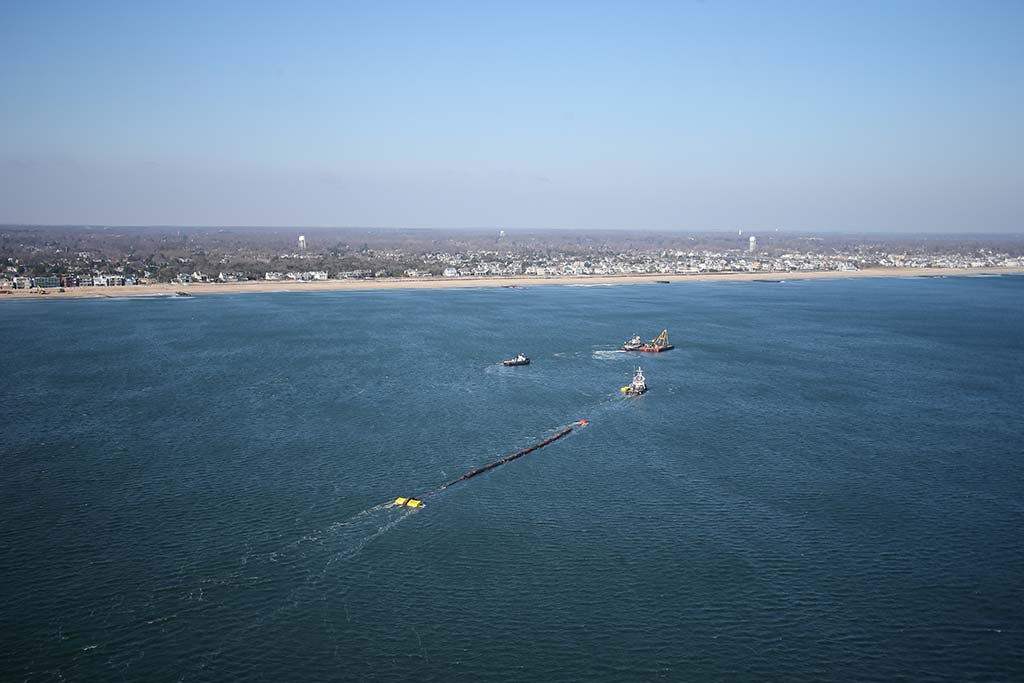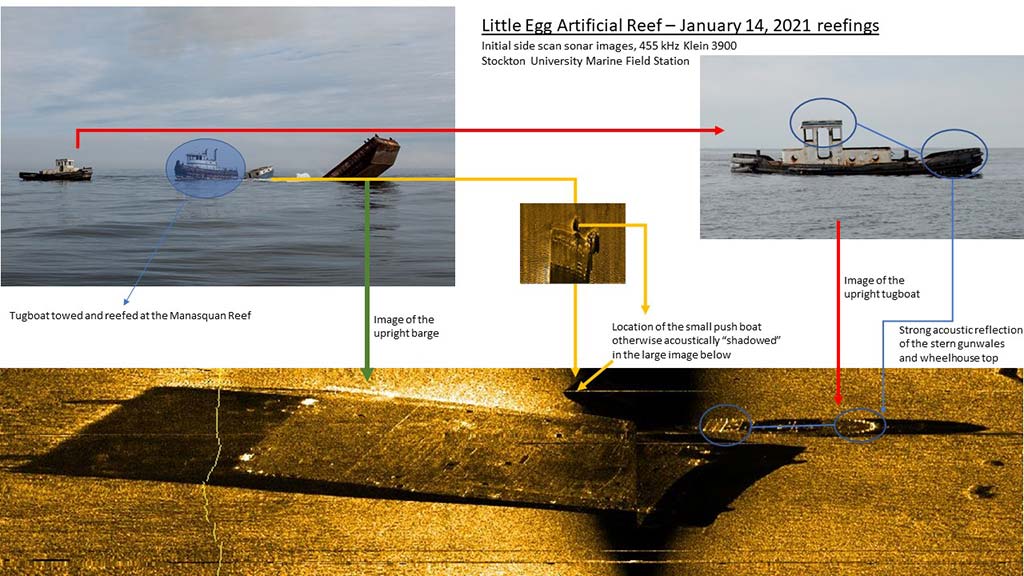
A boon to homeowners, and bust for surfcasters – but what’s the alternative?
Most would agree that beaches should remain attractive, functional, and prosperous to all, including to those other organisms with which we share beaches. Due to the roles of many beach organisms as essential forage to other species that we value as recreational and commercial natural resources, organismal diversity and abundance in/on beaches is especially important.
Some creatures, like nematodes and other meiofauna (nearly microscopic organisms that live between the sand grains(1-4)), have a dual role of ‘beach cleanup’ since they feed on organic debris, bacteria, and algae. These creatures are so vital that a beach’s health is often measured by their abundance and diversity.
The condition of any beach is dependent upon wave energy, sand supply, and its location relative to sea level. These three natural influencers continuously modify all beach profiles, some more drastically then others (4). The extent of sand supply and movement depends on wave energy, wind speed and direction, precipitation, relational position to other structures, and bottom contour.
The way in which all these factors culminate can cause intertidal zone transport, longshore transport, and/or onshore-offshore transport of sand (7). These give rise to two broader processes that greatly impact beach size and structure. These opposing processes are erosion and accretion.
Erosion & Accretion
In general, erosion means the gradual destruction or diminution of something. In surf dynamics, it specifically refers to that of the beach and is also referred to as ‘shoreline retreat’. The main way in which this occurs is when the aforementioned factors, especially short, steep waves, offset the balance of onshore transport to that of offshore transport (7). Stronger wind-driven currents influencing this process predominant New Jersey winters and falls (8).
Accretion is a lesser used term. In a sense, it is the opposite process of erosion where the beach widens or grows. Accretion is driven by opposite versions of the same factors that influence erosion. It is particularly promoted by long, less steep waves, offsetting the balance of offshore transport to that of onshore transport (7). Weaker wind-driven currents influencing this process predominant New Jersey summers and springs (8).
Both processes are normal, natural occurrences of the marine ecosystem. The way in which they both play out provides opportunity for micro- and macro-fauna to seed and pullulate. Even where and when opportunities are removed for some species (such as through accelerated erosion), the available marine nutrients are still in place to provide fertile niches for other life to take advantage (like benthic organisms in the larger wash zone after erosion events). Society, of course (except for most anglers), has justifiable incentive to hinder these natural processes to varying extents at different times and places.
Without mitigating them, to at least some extent, we would lose beachfront properties, ocean-adjacent infrastructure, and attractive sands for tourism. The real challenges are, first ascertaining the most effective and least damaging strategies to alleviate erosion/accretion, and secondly agreeing upon the optimal balance by which these natural processes are allowed to play out versus artificially curbed.
There are a variety of mitigation mechanisms that are implemented across regions, but one predominant and controversial one used here in New Jersey has become the bane of surfcasters and a source of contention.

Artificial Beaches
Beach replenishment is the artificial widening and heightening of beaches by bringing in sand from elsewhere. Though its use has increased dramatically in recent years, the United States Army Corps of Engineers (USACE) has been applying it to New Jersey beaches since the 1930’s (5,9–11). The beach in which the sand is placed is referred to as the target site, while the area from which it is drawn is the mine site. To do this, sand from the mine site is often dredged up and then pumped or delivered to the target beach. The sand is then further manipulated by bulldozing and other means to achieve an aesthetically acceptable contour.
As with any soft structure, artificial beaches are impermanent. They eventually degenerate as they are exposed to the same eroding forces, including those exacerbated by storms (12), which disintegrated the prior beach. Thus, this process requires continuous repetition.
Complicating things, this process goes by other names. Beach nourishment is a misleading euphemism used for beach replenishment. “Nourishment” is used because it describes the spatial renewal of beaches. However, great care was likely used in choosing this specific and pacifying term to officially describe the process as it implies the nourishment of life to a given area. Chances are that the latter is farthest from the truth.
From an environmental perspective, by circling back to a beach’s necessity for robust psammon (very small plants and animals that grow on, in, and/or move through beach sand), artificial beach addition may deplete organismal abundance and diversity (13–19). Replenishment is documented to have a variety of short and long-term negative impacts on beach ecology (20–22). Additionally, sand moved by dredging has to come from somewhere, so it is not only the target site that is affected, but potentially the mined sites as well (8,23). Alterations in the mining site contour may be agitating shoreline sand transport and shoreward wave direction, height, and energy. This most notably affects Long Beach Island and could be fostering “erosional hot-spots” (8).
Though in need of repetition and further analyses, some studies do suggest minimal change in beach ecology after replenishment (24). A review by the Atlantic States Marine Fisheries Commission (ASMFC) discusses different studies with contradictory implications for both mined and target sites (25). Interestingly, most of the studies suggesting innocuous impacts of beach replenishment came from sources that conduct or support in some ancillary way the actual process. To quote a study, “Monitoring is typically conducted through project promoters, with no independent peer review, and the permitting agencies exhibit inadequate expertise to review biostatistical designs” (26). A biological monitoring study, for the Asbury Park to Manasquan Inlet Beach Erosion Control Project, found little difference in flounder number near mine sites (27).
Science Supported Cons
Even among its questionably mild results, there were negative effects, like bluefish being absent from, and likely avoiding, areas undergoing the replenishment process (25,27). The exodus of predator species mirrors the anecdotal experiences of many anglers (this author included). Now relegated to the memories of many surfcasters, the Jersey Shore was once replete with trophy striper producing-bunker blitzes.
Other researchers believe the vibrant and noisy mechanics, and the increased local turbidity of the process vacate fish (14,25,28,29). Such migratory/behavioral changes in finfish populations have been downplayed through justification of some species’ transitory nature and wide range (30). However, this does not take into account impacts on the recreational and commercial fishing industries. Fish eviction may be preferred over fish destruction, but the former still harms anglers, often in disproportionate ways. Additionally, some studies strongly suggest mine sites ruin habitats and finfish communities (31).
Some reports suggest that artificial mediators of replenishment (i.e. bulldozing and dredging) destroy initially present ecology (4,18,20,23,32). Other studies strengthen this argument by illuminating the vulnerable New Jersey beach organisms (1–3) and beach-influenced fish species (18,33). Replenishment using coarser sediments than those inherent to the initial beach is likely to harm prevailing macrobenthic species (34). Research has demonstrated that the “associated environmental effects of replenishment [of Delaware Bay beaches] reduce habitat suitability for nesting [horseshoe] crabs” (3). More researchers stress the short term, large scale mortality on benthic life (8,20,35), while others detail broader, long-lasting problems (17,32,36).
Older studies highlight the financial and property-protective benefits of replenishment (37), though they often lack comprehensive comparison to alternatives and/or combinatorial approaches. Recall, soft structure is dynamic and at the whims of natural forces already described. It is not surprising then that artificial beaches made through replenishment tactics have been shown to lack durability (38), and can recede more rapidly than the initial natural beach (39). This impermanence in the end product exacerbates the financial costs, as the process requires long term repetition. The late director of the American Littoral Society, D.W. Bennett, once expressed concerns about beach replenishment and its economic infeasibility (38,40). Others describe the process as a difficult and unaffordable management scheme (32), very sensitive to budget cuts (41) and in need of stable funding (10). Some evaluations of soft structure shoreline stabilization on New Jersey barrier islands suggested that, “despite the apparent benefits, the policy appears to be a net cost to society” (6).
There are a variety of proposed ways, involving prudent, nuanced modification, which would alleviate the unpleasant impacts of replenishment (31,42). Ensuring that the mined sediment is similar in coarseness to that of the target beach is one of many examples (34,42).

Alternate Solutions?
So the answer is “yes, there are other alternatives to consider.” Hard structure stabilization can block wave and current energy (i.e. seawalls, revetments, and offshore wave-breaks), and subsequently reduce beach erosion/accretion. Certain types of hard structure are thought to impact nearby property values (12). However, hard structure alternatives have been successful in various locals throughout the world (43,44) though sparsely utilized in New Jersey (5).
Due to their permanence, they are likely cheaper long term than beach replenishment. Hard structure stabilization also spares the target beach from direct manipulation and disturbance. A less obvious side advantage to hard structure usage lies in its placement site. Hard structures of different degrees and to various extents actually benefit marine ecosystems!
Hard surface area provides seeding grounds for mussels and other mollusks, hiding spots for prey fish, and ambush points for predators. The seeding of lower food-chain species on hard structure, followed by the dynamic changes in associated species that follow, is called ecological succession. The ecological benefits of hard structure are more confirmed and understood than the ostensibly negative impacts of beach replenishment.
The angling community, and possibly the broader general public, has at least a surface understanding (pun intended) of these phenomenon. It is why fishermen push to form and fish on wreck, reefs, and rock pilings. Nearshore mitigation boulders and reefs have even been used to offset the ecological detriments of beach replenishment (45,46). Sometimes referred to as “fish attractors” (47), similar structures are used to successfully bolster marine ecosystems (48–51).
Organizations like Stockton University and Sea Grant Consortium are developing innovative ways in which to better assess ecological succession across various material, conformational, and geographically placed structures; and to optimize reef-building and related processes (52). Another example would be the NJDEP’s fish trap surveys of artificial reefs. Such studies are vital to fisheries sustainability and healthy coast ecosystems.
Dr. Adam Aguiar is a professor of biology at Stockton University and manages the ecology and saltwater fishing curriculum at the Atlantic City campus. The sources for the 54 numeric references listed in Dr. Aguiar’s article can be found at Footnotes: Beach Building: To Replenish, Or Not?
At the minimum, additional studies from non-bias organizations are required for a more accurate understanding of beach replenishment impacts (22,25,29,31,36,53). Clearer, more transparent cost comparisons need to be made between various versions of replenishment and its hard structure alternatives (12,54).
Even in the absence of additional data, however, logical speculation over this issue clearly suggests that the aforementioned alternatives to beach replenishment are environmentally and economically superior.



